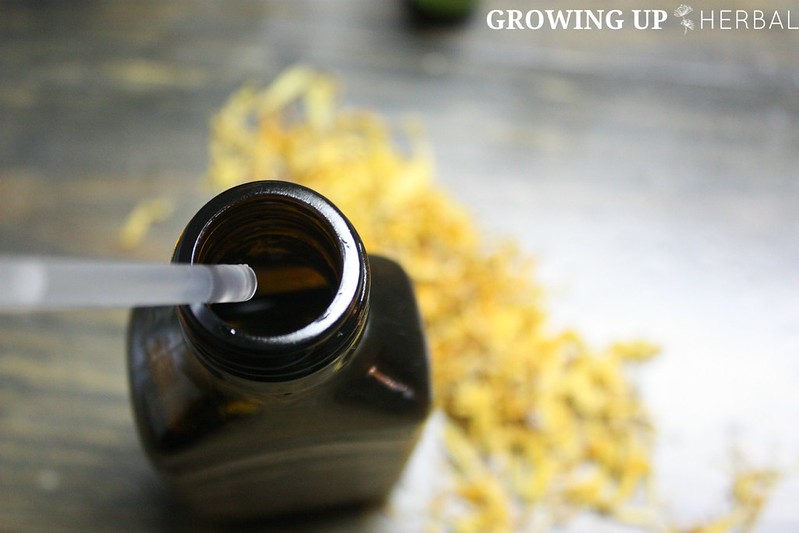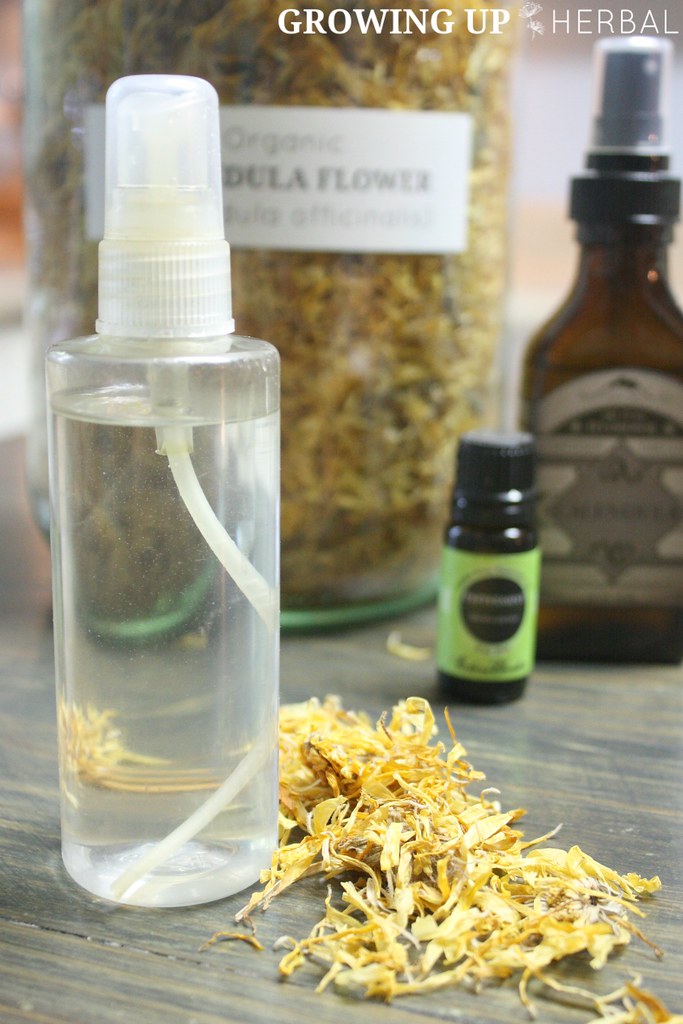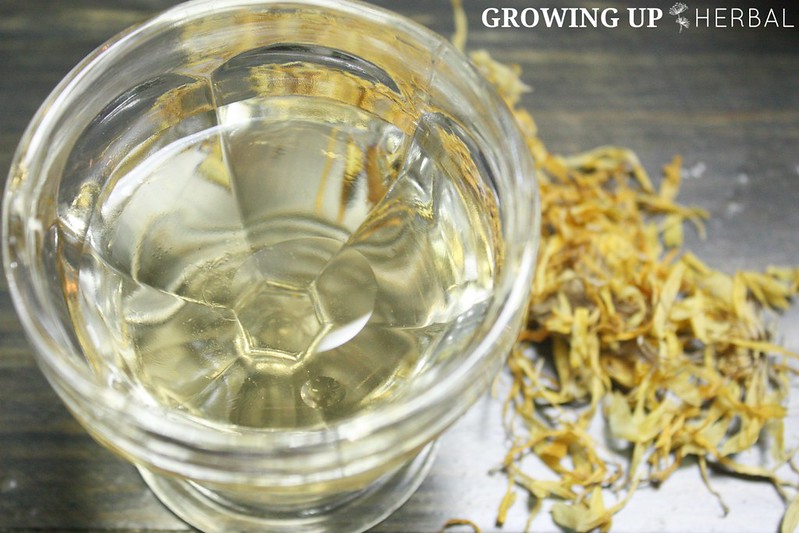
Welcome back to the last week of the June Herb Challenge… week 4!
Over the course of the last four weeks, we’ve learned a lot about the herb calendula. Today I wanna take some time to review some of what we’ve learned about this very useful herb as well as try to sum it up so it’s easy to remember. Plus, there’s one last weekly herb project, and I have a fun printable for you as well.
Calendula Review
So in order to keep from repeating all the info I’ve already shared about calendula with you, I want to point out the major things to remember about this herb… its actions and energetics. Remembering these two things will help you when it comes to knowing what calendula is used for.
1. Actions
Calendula is anti-inflammatory, astringent, and a vulnerary. Basically, it decreases swelling, tightens and tones tissue, and promotes skin regeneration. This is what makes calendula great for its skin uses.
Calendula is also antispasmotic and hemostatic/styptic. That means it relaxes smooth muscle cramps and helps decrease bleeding. This makes it great for stomach/intestinal/hormonal cramping and internal bleeding from ulcers or mouth sores. (FYI – Herbs that decrease bleeding when taken internally are called hemostatics while herbs that decrease bleeding externally are called styptics.)
2. Energetics
Calendula’s energetics are mainly cooling and drying. This means that calendula will help cool the body (think inflammation and fevers) as well as help to dry up wet conditions (like runny sinuses, diarrhea, and excessive bleeding).
It’s also slightly bitter and pungent. That means it has a strong smell and bitter taste which also helps to tighten tissues and stimulate digestive juices. It also is what gives it its bug repelling properties.
Actions + Energetics = Uses
When you put calendula’s actions with its energetics, you can figure out when to use calendula. Let’s look at some examples.
Cut Finger on Kitchen Knife: Calendula has styptic and astringent properties which will help it to stop this cut from bleeding. It also has antimicrobial properties so it will help keep the cut from getting infected, and vulnerary properties to promote wound healing. When addressing this situation, first, I would use powdered calendula inside this cut to stop the bleeding. Once the bleeding stopped, I’d gently soak it in a calendula tea to help wash the wound well. Lastly, I’d apply a calendula salve 2 x a day and bandage it until it’s healed.
Stomach Flu with Diarrhea: Calendula has anti-inflammatory and antispasmotic properties along with cooling energetics which will help calm the pain and swelling in the intestines. It also has antimicrobial properties which will help the body rid itself of whatever bacteria or virus that’s causing the symptoms. Plus, it’s an astringent and its energetics are drying so it will help tighten and tone the relaxed tissues, hopefully decreasing the frequency of diarrhea. When addressing this situation, first, I’d make an herbal electrolyte drink using calendula to stay hydrated, and then I’d start adding in 1 dropperful (30 drops) of calendula tincture every 2-3 hours on top of additional herbs to help decrease symptoms.
Sunburn: Calendula is a cooling herb with astringent, vulnerary, and anti-inflammatory properties which makes it great for hot sunburns. Speaking of using calendula with sunburns… that brings me to today’s herbal project below.
Week 4 Project – Calendula Spritzer
Hydrosols are amazing! Have you heard of them or used one before? Many times they’re referred to as “floral waters” or “distillates,” and they are exactly that.
Basically, a hydrosol is the steam (water) that is captured from making herbal tea (floral) using a distillation process, and it’s super beneficial.
To get a hydrosol, herbal material is distilled and the steam that comes up is captured. What’s left is a really strong herbal infusion, the hydrosol, and essential oil. The hydrosol and the essential oil are mixed together, but when left to sit, the EOs will rise to the top of the hydrosol water and can be siphoned off and separated usually leaving around 5% essential oil in the floral waters. Hydrosols are mild and have many of the same properties and actions as the plant itself.
Another great thing about hydrosols is that you can buy them or you can make them yourself at home using common kitchen equipment. Keep in mind though… homemade hydrosols are most-likely not of the same quality as commercially distilled hydrosols, however, they do still work well. If you make a large enough batch and you let it sit, you will have lots of hydrosol and a small amount of essential oils you can use. I have heard that you can freeze your hydrosol and pour off the essential oils that rise to the top. I’ve never tried it… I’m just telling you what I heard.
Now that you know a bit more about herbal hydrosols, let’s move on to using one.
Calendula Spritzer
This healing spray can be misted on sunburns, insect bites, rashes, minor cuts and scrapes, bee stings, inflammations, bug bites, or used as a medicinal and soothing facial toner for acne or other skin irritations.
Ingredients:
- 2 oz organic Calendula Floral Water (Hydrosol)
- 2 oz aloe juice/gel (optional)
- 10 drops Calendula Herbal Extract/Tincture (from week 2)
- 5 drops peppermint essential oil
Directions:
Mix all ingredients together and pour into a 4 oz bottle with a mister top. Use as often as desired!
Bonus Calendula Recipe
The recipe below can be used for problematic skin or even just blemish outbreaks that happen every once in a while. It uses soothing, anti-inflammatory and astringent herbs that are antibacterial to help dry up and decrease redness without over drying the skin.
Calendula Spot Treatment for Blemishes
- 1 TBSP calendula hydrosol
- 1 dropperful (30 drops) parsley or yarrow extract (tincture)
- 3 drops tea tree essential oil
- 2 drops lavender essential oil
Combine all ingredients together, bottle, and label. Apply as needed to blemish spots. Be sure to shake well before use.
Calendula Herb Challenge Final-Quiz
Answer the questions to see how much you remember!
- What are the primary actions of calendula that make it effective for skin conditions?
- What is the herbal action called that stops bleeding?
- How much essential oil is typically found in a hydrosol?
- Do hydrosols have different constituents than the herb they were distilled from or similar constituents?
- What are the two main energetics of calendula?
Adiós & Thank You!!
Wow! I can’t believe we’ve made it four weeks through this herb challenge together! I’ve learned so much, and I’m hoping you’ve learned a lot as well. Above all, I hope you’ve had a great time doing this with me, and I hope that calendula becomes a regular part of your natural first aid kids as well.
Before you go, I wanted to give you a little something to remember this challenge by. I’ve created a materia medica page on calendula for you to tuck away somewhere safe so that when you wanna recall this information you can easily pull it out and you’ll have everything right at your fingertips… no need to search the web for it! Enjoy!
If you’d like to stay up-to-date on what’s going on here at GrowingUpHerbal.com, there are a couple ways you can do that. First, you can subscribe to my Letters To Natural Mama emails. This is where you’ll get the latest announcements and plans. Next, you can subscribe to my blog posts so you don’t have to remember to come visit the blog, you’ll get an email each time a new post is published.
Again, thank you for taking the time to learn and grow with me! I appreciate you so much!




Can I use a different e.o. in the place of peppermint? I’m breastfeeding and trying to avoid it 🙂
Sure Morgan. Tea tree and lavender would work well too!
I just stumbled upon your website. I’m a big fan! I’m very excited to learn all about herbology through your site. Yay!
Welcome, Nicole! Glad you are here!
5